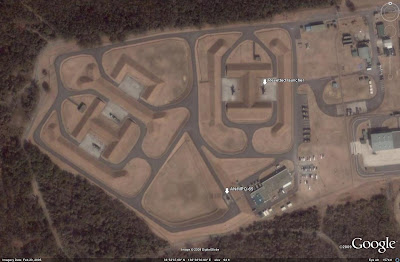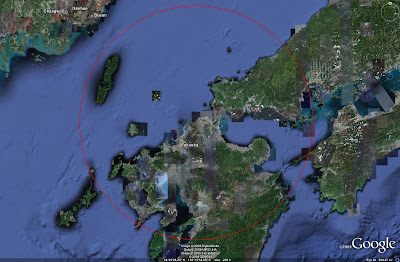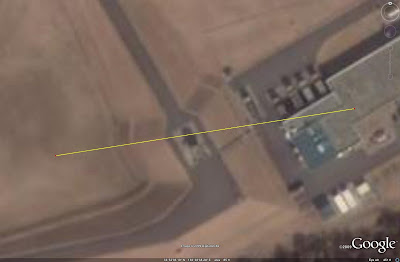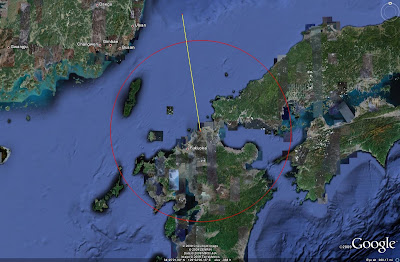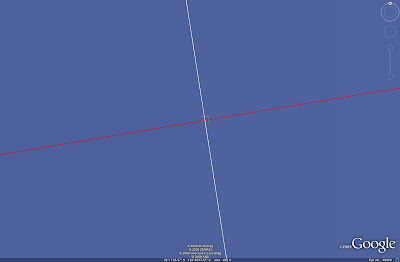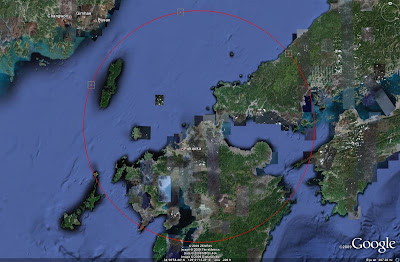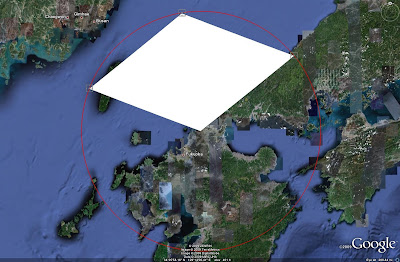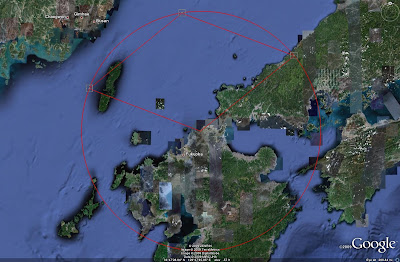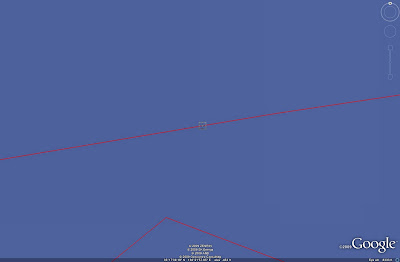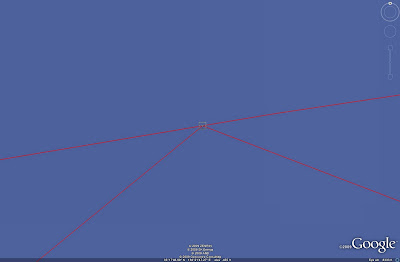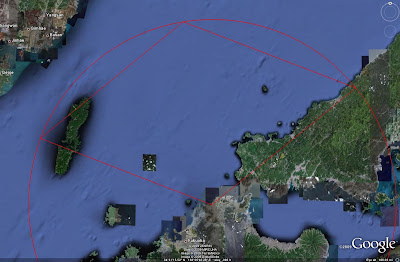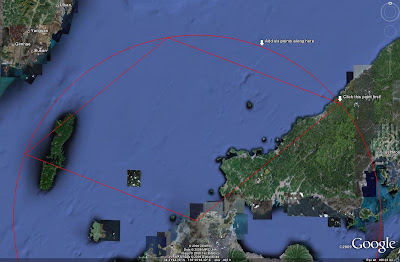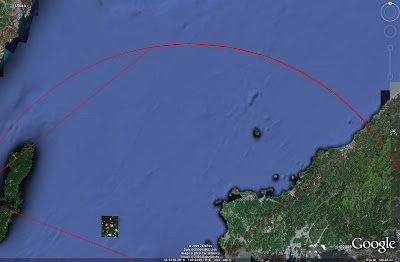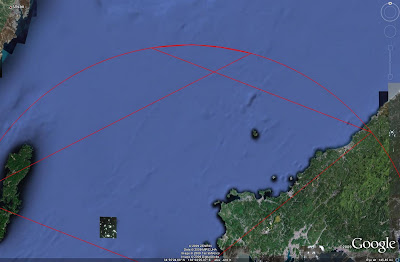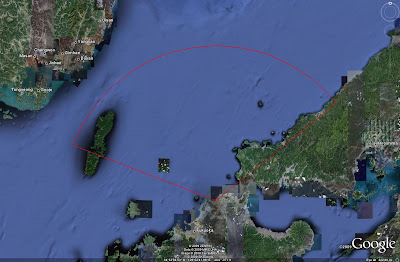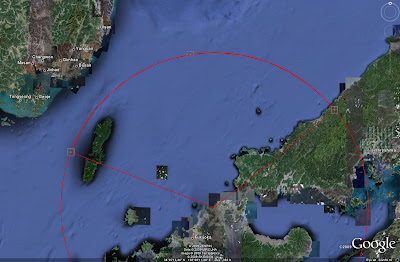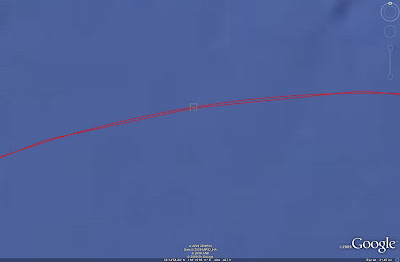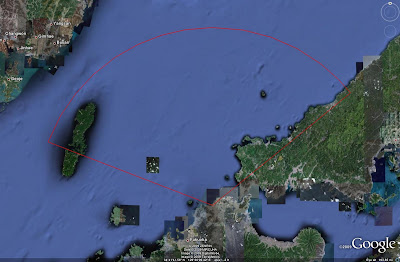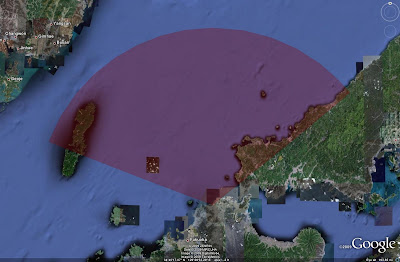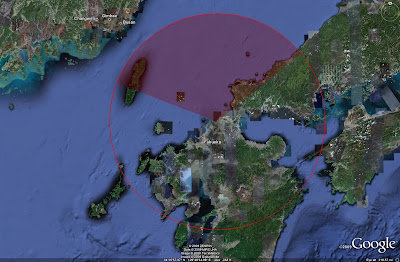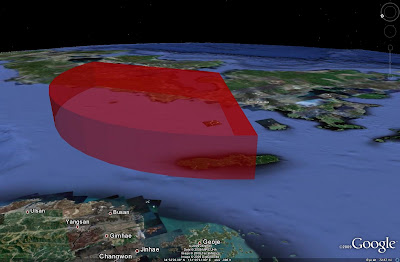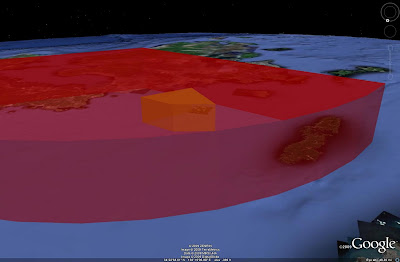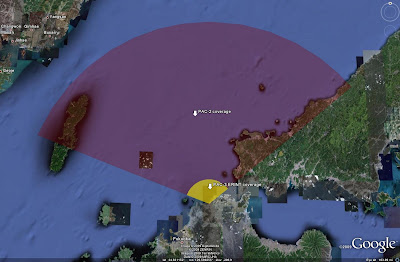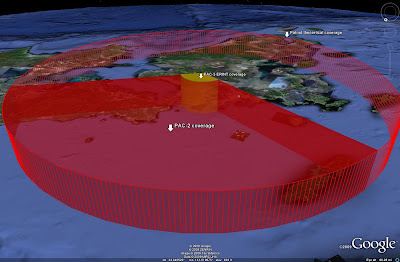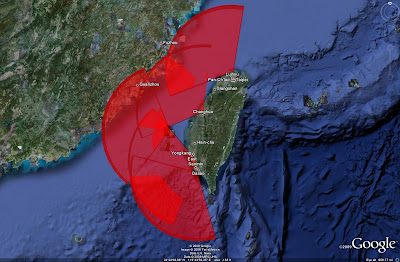INTRODUCTIONThe island of Taiwan sits less than 200 kilometers from the coast of the People's Republic of China. Faced with a potential threat consisting of over a thousand ballistic missiles and swarms of strike fighters, Taiwan's strategic SAM network is a significant element of the island's defense.
2/71 AND NIKEStrategic air defense of Taiwan began in the 1950's during a highly classified US military deployment to the island. Soldiers and equipment from Fort Bliss deployed to Taiwan as the 2nd Battalion, 71st Artillery, forming a four battery MIM-14 Nike-Hercules SAM network along the northwestern edge of the island. The deployment of US Army personnel only lasted for a year, but the seeds were sown for Taiwan's strategic air defense network. Not only did Taiwan retain the four Nike-Hercules batteries previously operated by the US Army, but a further four batteries had been procured at some point before the mid 1970s. These systems represented the first significant strategic air defense network to appear in the cross-strait conflict zone, and were retired in 1996.
GENERAL LAYOUTTaiwan's present-day strategic air defenses are oriented logically with respect to the perceived primary threat to the nation's security: the People's Republic of China. The bulk of the air defense assets are located on the northern and western sides of the island, with their sensors illuminating the cross-strait environment to monitor for any unauthorized inbound traffic. Air surveillance is provided by eleven EW facilities, and engagements are prosecuted by twenty two fixed missile batteries, occupied by HAWK, Patriot, and Tien Kung SAM systems. These systems have engagement ranges of 40 kilometers, 160 kilometers, and 200 kilometers, respectively. A further twenty two Skyguard facilities are located to provide close-in defense of key population centers and military facilities, some of which are equipped with 18 kilometer range RIM-7M Sparrow missiles.
The following image depicts the general layout of Taiwan's strategic air defense network. EW sites are marked with blue diamonds, the CSIST Missile Test Facility is marked with a brown square, and SAM sites are marked as follows:
HAWK: Orange triangle
Patriot: Yellow triangle
Tien Kung: Red triangle
Sparrow: Green triangle
Inactive: White triangle
 HAWK
HAWKTaiwan acquired the MIM-23 HAWK SAM system in the 1960s. Thirteen prepared HAWK sites are currently occupied by active batteries. One battery is located offshore in the Penghu island group. The remaining sites wrap around the western coast of Taiwan at intervals of roughly 65 kilometers. Taipei and Kaohsiung, Taiwan's largest population centers, are defended by three sites and two sites respectively, with closer spacing to provide a greater degree of overlap in their fields of fire. Three sites are present on the eastern shore of the island, situated to defend the three main population centers in that region.
The locations and coverage of Taiwan's HAWK batteries can be seen in the image below:
 TIEN KUNG
TIEN KUNGCSIST began to develop the Tien Kung SAM system in the early 1980s, envisioning a replacement for Taiwan's aging HAWK batteries. The system has been produced and deployed in two variants, the Tien Kung I (TK-I) and the improved Tien Kung II (TK-II). An ATBM Tien Kung III is in development. The TK-I was originally fielded in both static and mobile variants, with the TK-II only being deployed in a static variant. In 2006 it was announced that the TK-I was being retired and replaced by the TK-II. It was not specified if the TK-Is were only being replaced in the static launchers, or if the mobile TK-Is would be withdrawn as well.
The TK-I was deployed on a trial basis in 1989 and declared fully operational in 1993. The TK-II was deployed in 1996. The TK-I had an engagement range of 100 kilometers, with the TK-II having a range of 200 kilometers and adding an active radar terminal homing seeker. The TK-I, in contrast, relied on SARH for terminal homing. Both systems receive target acquisition and midcourse guidance support from an ADAR-1 Chang Bei LPAR. In the TK-I, a CS/MPG-25 continuous wave illuminator provides the necessary target illumination during terminal homing for the SARH guidance method.
The static SAM systems are deployed in silo launchers at six fixed sites, two sites being located offshore. One is located in the Penghu island group, and the other is located in the Dongyin island group. These silo launch facilities are unique in the field of air defense; no other active land-based SAM system in the world uses a silo-based launch method. Each silo launch complex consists of two separate areas: a silo launch facility and a radar facility.
The silo launch facility consists primarily of five underground launch complexes. These complexes each house four four-round vertical launch cells for TK-I or TK-II missiles, for a total of 80 missiles per complex. Two CS/MPG-25 CW illuminators are present at each complex.
The image below depicts a silo launch facility constructed on the grounds of a former Nike Hercules launch site.

Mobile TK-I systems may be deployed at these fixed launch facilities in some capacity, either to augment the silo-mounted TK-IIs or simply to utilize the garrison facilities before being field deployed as required. It is possible that mobile ADAR-1 LPARs could also be employed at silo launch facilities to increase the target engagement capacity of a single battery. Whatever the case, CS/MPG-25 illuminators were still emplaced at static launch complexes imaged at various points in 2006, implying that TK-Is were possibly still present in some capacity and had at the very least not yet been fully removed from silo launchers.
The radar facility consists of a fixed, hardened ADAR-1 LPAR. One radar facility is attached to each silo launch facility. The two facilities are separated by a distance of between one and four kilometers and are treated as a single complex. Separating the complexes allows for the hardened radars to be built into bunkers which are at a higher elevation than the launch facility. This allows the radars to have a less cluttered field of view without employing far more vulnerable mast-mounted antennas, and to mitigate the effects of the
radar horizon on the system's engagement envelope.
The image below depicts an ADAR-1 radar facility:

Both of the above images are interesting in that they are both censored in the default Google Earth imagery set. They can only be accessed through the historical imagery feature. Various Tien Kung associated facilities can only be viewed in this fashion.
While the Tien Kung SAM system has a maximum range of 200 kilometers with the latest TK-II variant, the engagement zones of these fixed launch sites are oriented in specific directions. The fixed ADAR-1 LPAR has a 120 degree field of view in azimuth, able to scan 60 degrees to the left and right of center. This determines the engagement zone available to a missile fired from the associated fixed launch site. Mobile radars could theoretically be employed to increase the coverage zones, but it is not known if the TK-I's mobile ADAR-1 sets are compatible with the silo-launched TK-II missile. It would seem likely that they are, or could be with minimal modification, given that the hardened ADAR-1 radars are still employed by the TK-II system.
The locations and engagement zones of the five southern fixed launch sites can be seen in the image below. The zones are oriented to match the likely fields of view of the hardened ADAR-1 LPARs and correspond to the 200 kilometer TK-II system. A TK-I fired by a fixed launch site would engage a target within the same zone, but only to half the range. The Dongyin island group Tien Kung site is not included as the LPAR field of view cannot be determined due to a lack of high-resolution imagery.
 PATRIOT
PATRIOTIn 1993 Taiwan purchased three MIM-104 Patriot SAM batteries from the United States, receiving PAC-2 standard weapons. Taiwan's three Patriot batteries became operational in 1998 and were deployed at prepared sites near Taipei for capital area air defense, focusing on an ATBM role. The AN/MPQ-65 radar, when emplaced, has a field of view of 120 degrees in azimuth. The radar is not rotating for full 360 degree coverage, rather it is aligned in the direction of a potential threat axis when deployed. While the radars can be repositioned and realigned when needed, historical imagery indicates that these three batteries have remained aligned in the same general direction since at least 2000.
The locations and coverage zones of Taiwan's Patriot batteries, as currently imaged, can be seen below:
 SKYGUARD-SPARROW
SKYGUARD-SPARROWThe final component of Taiwan's strategic air defense network are the close-in, point defense RIM-7M Sparrow SAM systems integrated with Skyguard batteries. The locations of identified Skyguard installations, along with the coresponding engagement zones for the Sparrow-equipped batteries, can be seen in the image below:
 OVERALL COVERAGE
OVERALL COVERAGEThe main issue facing Taiwan is numerical. With an estimated 1300-1500 ballistic missiles and hundreds of strike aircraft targeting the island from the People's Republic of China, it would appear that Taiwan simply cannot afford to procure and deploy enough land-based SAM systems to guarantee clear skies in a time of crisis. That is not entirely true, however, given a complete understanding of a potential conflict. The People's Republic of China wishes to reintegrate Taiwan with the mainland, not acquire a new bombed-out target range for its military forces. Logically speaking, while certain targets are likely to be struck during a military engagement, and likely struck multiple times to increase the chances of oversaturating the air and missile defenses, it is not likely that the PLA will simply bombard the island into submission. Simply speaking, that would completely defeat the point of any military confrontation designed to reintegrate Taiwan. Therefore, when faced with a numerically superior force desiring to eliminate key military facilities rather than to obliterate the entire island, the logical approach would be to employ strategic SAM assets and air interceptors in an integrated air defense system (IADS).
In an integrated warfighting environment, TK-II SAMs could be employed beyond a certain range to thin out inbound formations, while air interceptors remain on station to combat the remaining inbound aircraft. Any cruise missiles or aircraft penetrating the combat air patrol zones could be engaged by HAWK SAMs, as well as SHORAD systems such as Skyguard. Naval SAM systems could also be employed offshore to provide further assistance in thinning out any inbound aggressors. While this strategy would likely still result in a number of successful strikes, it represents a logical, organized use of the assets at hand when faced with a numerically superior threat.
Taken as a whole, the strategic SAM network on Taiwan is well organized. Engagement zones have a significant degree of overlap, allowing targets to be shared by multiple systems, and HAWK batteries are logically deployed as both a closer-in defensive line and a gap filler to eliminate holes in the network created by the azimuth limitations of the hardened ADAR-1 LPAR facilities.
The overall coverage zones of Taiwan's strategic SAM systems can be seen in the image below. As mentioned previously, the Dongyin island group Tien Kung site is not illustrated.

It should be pointed out that the eastern side of the island is relatively undefended in terms of SAM coverage. This should not necessarily be seen as a weakness in the overall network, as the bulk of the military and political targets likely to be struck during a conflict are not in this region.
It has been reported that Taiwan possesses eighteen or twenty HAWK batteries, but there have only been thirteen HAWK sites identified. The remaining batteries are likely held in reserve for attrition replacement and training purposes. They are also potentially available to be field deployed during a crisis to reinforce air defenses in certain sectors. Likewise, existing HAWK batteries could be removed from their fixed locations and deployed to field firing positions, as could Patriot or extant mobile TK-I units.
There is evidence suggesting that plans may exist for redeploying Patriot and/or TK-I batteries during a crisis. The following image represents a Patriot or TK-I mobile SAM site constructed on the grounds of a former MIM-14 battery. The image was captured in late 2004, when Taiwan only possessed three PAC-2 Patriot batteries. These batteries were all intended primarily for ATBM defense of Taipei, as previously mentioned, and were already sited in that region. Ergo, this unoccupied facility was likely not intended to house a permanent Patriot battery, as the only Patriot batteries in Taiwan were already positioned according to their intended role. It is, of course, possible that this facility was home to a mobile TK-I battery which has since been deactivated, but that does not preclude the site from being used as a deployment site in the future.

One oddity that stands out when analyzing the coverage zones of Taiwan's strategic SAM network is the presence of a corridor north of the Penghu island group, heading roughly north towards the Chinese mainland, which is only defended by a single Tien Kung fixed launch site. This is unusual because care has apparently been taken to ensure a degree of overlap in most of the network. This corridor could simply be an aberration of geography meant to be filled by a naval SAM system, it could be a purposely less-defended corridor for civillian traffic meant to be filled by a mobile TK-I battery in the Penghu islands, or it could represent a "safe zone" for outbound strike aircraft. The latter example is noteworthy; as the corridor passes over the Chinese mainland, it is flanked on either side by a Chinese S-300PMU-1 (SA-20A GARGOYLE) SAM battery. This could have been identified by the People's Republic as a potential ingress route for Taiwanese strike aircraft desiring to enter the Chinese mainland and attack ballistic missile launch positions and garrisons. The PLA's DF-11A garrisons at Xianyou and Yong An, along with the DF-15 garrison at Nanping, would likely be within reach of such a strike package. This is, however, pure speculation, but does draw attention to the types of data which could potentially be revealed by analyzing an air defense network.
FUTURE PROSPECTSIn the future, Taiwan's goal is to greatly increase the effectiveness of its strategic air defense network against ballistic missiles. To that end, CSIST has been developing the TK-III, an ATBM off-shoot of the TK-II. The Taiwanese government has also been in negotiations with the United States to procure PAC-3 series Patriots with their associated ERINT ATBMs.
The ERINT ATBM has a range of 20 kilometers against a ballistic target, and is designed as a hit-to-kill weapon with very high accuracy. An enhanced variant is being developed which would increase the ATBM range to 45 kilometers. In January of 2009 it was reported that Taiwan had received approval for a contract with Raytheon to upgrade the three existing PAC-2 batteries to PAC-3 standard, enabling them to support the ERINT missile. Taiwan is still negotiating the sale of 330 ERINT missiles as well as four AN/MPQ-65 radars and other Patriot components to deploy three or four additional Patriot batteries.
The footprint of the Taipei PAC-2 sites, when upgraded and equipped with PAC-3 ERINT weapons in an ATBM capacity, can be seen in the image below:

Taiwan is also developing a new SHORAD system based on the Tien Chien II (TC-2) BVR AAM, to be integrated with the Antelope SHORAD system as a Skyguard replacement.
STEALTH OFFENSENo discussion involving the TK-II SAM system would be complete without a brief mention of the Tien Chi surface-to-surface missile derivative. This weapon is a 320 kilometer range system fired from static TK-II launch sites. It is believed that the system is deployed in two locations, and that one of them is the Tien Kung facility in the Dongyin islands. The other is likely the Tien Kung facility in the Penghu islands, as offshore basing does allow for greater inland reach of mainland China.
The following image depicts some of the potential targets for the Tien Chi missiles, assuming that they are based at the two aforementioned locations. The missile locations and their associated ranges are indicated in white. Do note that not only is one of China's OTH-SW systems within range of the Dongyin site, but that it can also reach the two S-300PMU-1 batteries mentioned previously. The main drawback of the system, however, is short range; the image depicts the PLA's 52nd Division ballistic missile units, and only two of them are within range of the Tien Chi system. Given the sheer number of Chinese ballistic missiles available in the theater, it is more likely that the Tien Chi is intended for high-value targets such as the OTH-SW system.
 CONCLUSION
CONCLUSIONTaiwan's strategic SAM network has been arranged logically given the potential threat it has been designed to counter. As more ATBM systems are developed, the network will continue to evolve into a more modern, capable system, in much the same manner that the network of Taiwan's cross-strait rival has evolved. While the SAM network is not capable of deterring a massed, large scale attack, it is modern and credible enough to act as a potential deterrent against small-scale incursions or attacks, and therefore is a stabilizing force in the region.
GOOGLE EARTH PLACEMARK DATAA Google Earth file containing the placemarks used in the generation of this article can be downloaded
here.
ADDITIONAL DISCUSSIONFeel free to discuss the content of this article at the IMINT & Analysis Forum in the discussion thread found
here.
SOURCES-Special thanks to IMINT & Analysis forum members Planeman and BryanC for acting as sounding boards and discussion partners during the creation of this article
-Satellite imagery provided courtesy of Google Earth
-Jane's Land-based Air Defence, various editions
2nd Missile battalion, 71st Artillery (Taiwan) AssociationTaiwan: Missile ProfileTaiwan to Upgrade to Tien Kung-2 SAMTaiwan switches from Tien Kung I to Tien Kung IITien ChiThe AN/MPQ-65Raytheon welcomes PAC-3 dealFMS: Taiwan Seeks 330 Patriot PAC-3 Missiles and Four MPQ-65 Radar Sets





